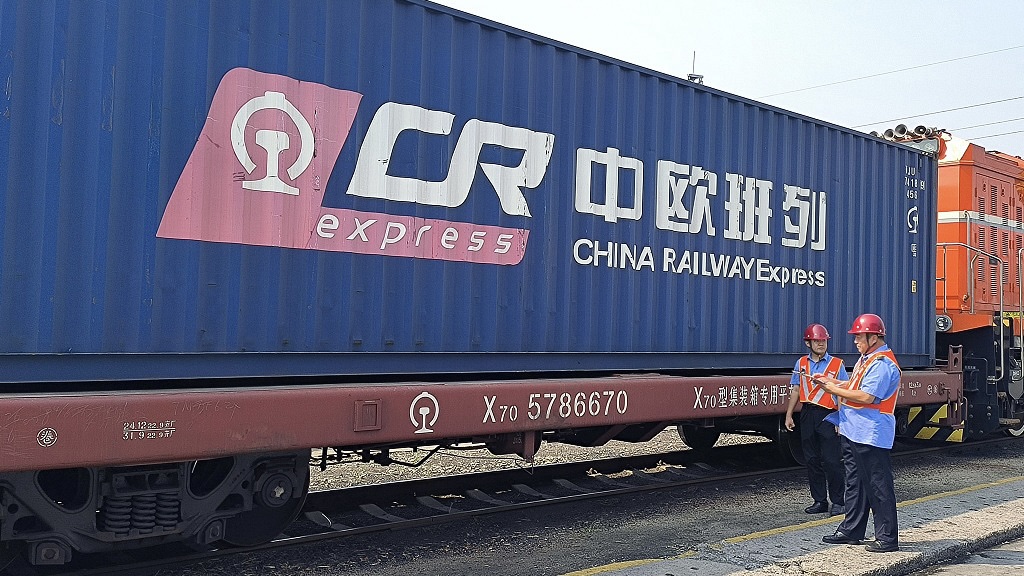BRI: A new driver for unimpeded trade

[ad_1]

China Railway Express in Tianjin port. /CFP
China Railway Express in Tianjin port. /CFP
BRI: A new driver for unimpeded trade.mp3
00:00
Editor’s note: The article is part of CGTN’s series called “New Chapter of the BRI”, in which global economists and eminent academics share their views and insights on the development and opportunity of BRI. Liu Hongkui is an associated researcher at the Institute of Economics, Chinese Academy of Social Sciences. The article reflects the author’s opinions and not necessarily the views of CGTN.
This year marks the 10th anniversary of the Belt and Road Initiative. The Belt and Road Initiative encompasses various fields, with unimpeded trade being one of its most fundamental and essential components. Over the past decade, the trade volume between China and BRI countries has grown steadily. Data reveals that from 2013 to 2022, the total import and export value between China and BRI countries soared from 6.5 trillion yuan to 13.83 trillion yuan, with an average annual growth rate of 8.6 percent. Its proportion in China’s total import and export value rose from 25 percent to 32.9 percent. In particular, over the past 10 years, the total import and export value between China and Association of Southeast Asian Nations (ASEAN) countries witnessed an average annual growth rate of 9.9 percent, 4.3 percentage points higher than China’s overall import and export growth. ASEAN has progressed from being China’s third-largest trading partner to its largest. In the first half of 2023, the total import and export value between China and BRI countries reached 6.89 trillion yuan, marking a year-on-year increase of 9.8 percent, surpassing China’s overall foreign trade growth by 7.7 percentage points. It accounts for 34.3 percent of China’s import and export volume.
The substantial growth in trade between China and BRI countries vividly illustrates how the Belt and Road Initiative propels unimpeded trade worldwide. The primary driving force behind this is the Belt and Road Initiative’s creation of new trade routes, development of novel trade patterns, and inclusion of more partner countries in the global trade network.
Firstly, the Belt and Road Initiative has established new trade routes. Over the past decade, China and BRI countries have strengthened the connectivity of trade infrastructure, successfully constructing several trade routes and corridors. For instance, China and Pakistan have made significant progress in building the China-Pakistan Economic Corridor and facilitated the construction of highways, railways, and oil and gas pipelines from Kashgar in China’s Xinjiang Uygur Autonomous Region to Gwadar Port in southwestern Pakistan. By the end of 2022, these efforts had brought a cumulative direct investment of $25.4 billion to Pakistan. Another achievement of the Belt and Road Initiative is the China-Laos Railway, which stretches 1,035 kilometers from Kunming in China’s Yunnan Province to Vientiane in Laos. It has become an imperative trade route for economic and trade cooperation among partner countries. Furthermore, the China Railway Express has opened a channel for land transportation between China and Europe, serving as a new Eurasian land bridge and playing a pivotal role in promoting trade among Asian and European countries. Over the past decade, the China Railway Express has completed a cumulative total of 77,000 train journeys, transporting 7.31 million standard containers with a total value exceeding $340 billion. It reaches 217 cities in 25 European countries and has evolved into a crucial bridge for international economic and trade cooperation.
Secondly, the Belt and Road Initiative has fostered new trade patterns. The new trade routes have not only introduced new land-based logistics methods but also transformed traditional trade patterns, giving rise to a new international economic cycle. In the future, as they are further improved, these new trade routes will promote the formation of new models of international division of labor and enhance international cooperation in the industrial chain and supply chain between China and BRI countries. The extensive operation of the China Railway Express, along with the establishment of overseas stations and warehouses, will also drive the cross-border e-commerce development in partner countries, ushering in new procurement and sales models.
Thirdly, the Belt and Road Initiative has enabled more developing countries and landlocked countries to integrate into the global trade network, contributing to their trade growth. The formation of new trade routes and trade patterns has significantly reduced international trade costs and boosted efficiency for developing countries and landlocked countries. Consequently, this has led to a more balanced regional distribution of international trade. In particular, the Belt and Road Initiative has provided more countries, especially developing countries, with better access to the Chinese market, allowing them to share China’s development achievements and thus driving China’s broader trade cooperation with developing and landlocked countries. Ultimately, more countries can enjoy enhanced trade benefits.
[ad_2]
Source link





